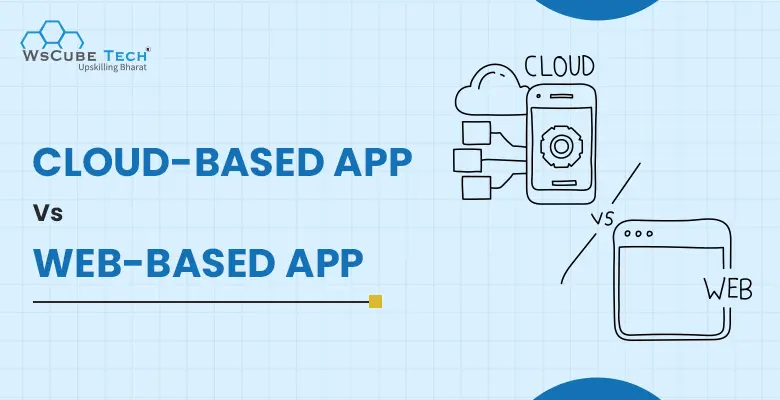Cloud computing is undoubtedly the present and the future. It is among the hottest technology trends over the last few years and had a major impact on businesses across every industry.
The web development industry is no different. Today, websites and web apps are also based on cloud services. But what difference does it make? What is the difference between web applications and cloud applications? What should you choose for your business— a cloud-based app or a web-based app?
In this comprehensive article on the comparison between cloud-based app v/s web-based app, let’s understand everything in detail.
Upskill Yourself With Live Training
What is Cloud Computing?
The term ‘cloud’ refers to a computing architecture in which data and software are stored and accessed via the internet rather than your computer’s hard disk.
The word cloud is a metaphor for the internet. It dates back to when the internet was depicted as a fluffy white cloud in flowcharts and presentations.
Cloud computing is the internet’s use to access data and programs. On the other hand, most individual users may never realize how much data processing occurs on the other end of the connection.
With an internet connection, cloud computing may be done anywhere and at any time. Clouds can be both public and private.

What is Role of Cloud Computing in Web Development?
The advantages of cloud computing, when combined with web development, should not be overlooked. It benefits the IT sector by providing numerous advantages to web app developers.
For instance, most of the popular websites, web apps, and mobile apps are today hosted on cloud services like Amazon Web Services (AWS), Microsoft Azure, IBM Cloud, Google Cloud Platform, etc.
The primary benefit of cloud computing in web development is that it offers scalability and is available on a pay-per-use basis.
Various technologies employ web-based applications to carry out their daily tasks. Indeed, web development has evolved into the use of web technologies that guarantee 99.9% uptime for your apps.

What is Cloud-Based Application?
Cloud applications are similar to web-based apps. These apps use cloud data and can also be accessible offline.
Cloud apps are a hybrid of regular desktop software and standard web apps. Cloud-based apps have many advantages over web apps because they are a more advanced type of web app.
Because these apps work in the cloud, they do not require a lot of storage space. Some common examples of cloud apps are Evernote, SalesForce, Dropbox, Zoho, etc.
Interview Questions for You to Prepare for Jobs
Types of Cloud-Based Application
Following are the main types of apps based on cloud:
Software as a Service (SaaS)
SaaS is the most popular cloud-based app, where users can utilize cloud-based apps as full-functioning applications given by technology suppliers as technology products/services.
SaaS apps are primarily intended for SMBs, large organizations, and freelance service providers. Free, pay-for-use, subscription and quote-based SaaS pricing methods are available.
HubSpot CRM, Wrike, Freshsales, Sisense, and Wix are some prominent SaaS examples.
Platform as a Service (PaaS)
This advanced cloud computing provides the infrastructure, solutions, and computing platforms for customers to create their solutions.
PaaS apps are mainly used by enterprises that build, test, collaborate, and deploy cloud solutions for specialized applications.
Microsoft Azure, Google App Engine, and Rackspace Cloud Sites are examples of PaaS cloud-based programs.
Recovery as a Service (RaaS)
These cloud-based solutions are used by businesses to recover data, files, databases, servers, and entire data centers.
RaaS provides comprehensive solutions for companies looking to replace existing solutions for business continuity, disaster recovery, archiving, and backup.
These cloud programs, often known as DRaaS (Disaster Recovery as a Service), work to reduce the effects of downtime. RaaS providers that are popular include nScaled, WindStream Business, and Geminare.
Infrastructure as a Solution (IaaS)
It is a cloud-based computing infrastructure service that is completely outsourced. Business clients will receive pre-configured and built-in software or hardware via a virtualized interface, and it is totally up to them how they will use these cloud services.
Some leading IaaS apps are IBM Cloud, Amazon WorkSpaces, and Google Cloud, which are available as development environments or managed hosting.
Suggested Reading: WordPress Security Guide: Best Practices & Tips to Secure Your WordPress Site?
Examples of Cloud Applications
Gmail is a simple example of a cloud app. It was always meant to be this way.
We’ve been using Outlook and other applications to view emails saved on the Internet, such as Gmail (Yahoo, Hotmail). Access information and storage on the cloud via any interface, web-based or otherwise. Furthermore, email is accessible offline if users enable it.
DropBox, Sugar Sync, ShareFile, Salesforce, NetSuite, Mozy, Zoho.com, and Evernote are typical suspects.
Twitter is also a cloud app. It can be accessed via smartphones even without a web browser interface. However, the app is not fully functional on the phone. Instead, the phone is simply an interface for accessing data and applications stored in the cloud.
Key Features of Cloud Apps
Cloud apps have the following features or characteristics:
- Data is saved in the cloud on a remote server. To support offline mode, can cache data locally.
- Cloud apps can be downloaded on mobile devices or accessed through web browsers.
- These programs provide various functions, including backup, security, and storage.
- Through customization, these apps may satisfy various types of user requirements.
- Cloud apps make it easier to access a broader range of services.
- Cloud services can help to boost productivity and profitability by streamlining work procedures.
- These programs use pooled resources to support several users with varying physical and virtual requirements.
- The resource utilization may be effectively reported, monitored, and controlled. It provides users and resource providers with a high level of transparency.
Cloud-based Web Application Example
Web services such as electronic banking, online shopping software, and eBay fit under this category for many because they are entirely web-based with few consumer customization choices.
Another example would be Facebook and other comparable web applications.
Must Read: Magento vs WooCommerce Comparison: All Differences
What is Web Based Application?
Web apps are nearly always meant to be accessed using a web browser. A web application is often built using a combination of server-side script (ASP, PHP, etc.) and client-side script (HTML, JavaScript, CSS).
The web browser relies heavily on web server components deployed on backend infrastructure systems to provide its fundamental functioning online services.

Key Features of Web-Based Apps
There are so many advantages that it is worthwhile to consider establishing a web application. But, first, look at some of the most important features:
- Mobile-First Interface
- Social Integration
- Reporting & Analytics
- Security
- Online Payments
Types of Web-Based App
Static web application
The static web application is the first web application available on the Internet. It is developed using HTML and CSS to assist in displaying actual content and information.
This is usually a rudimentary web application because it has minimal range and is not flexible. Usually, these programs do not allow for customizing and will only make changes after the page has completely loaded.
Although it supports animated items such as GIFs and videos, changing the content of a static web application is difficult because it necessitates obtaining, altering, and returning HTML code. As a result, this app is best suited for software development firms and experienced webmasters. Digital resumes, and lead capture pages in marketing are two excellent examples.
Related Reading: List of Top 7 Front End Development Languages
Dynamic Web application
Dynamic web applications give real data based on user requests and are regarded as one of the most significant web application types. When compared to static web applications, they have higher technical sophistication.
Numerous interaction components and approaches direct the client’s attention to the web app’s services and products. Web apps use databases to store all private and public data displayed on the Website.
They typically contain an admin panel that allows the administrator to handle the backend and frontend elements of the web app, as well as edit the content and include other interactive components.
The dynamic web app is created utilizing a variety of programming languages, including PHP and ASP.NET.
E-Commerce web application
When your web application advertises products or services to potential clients directly, it is referred to as an e-commerce web application similar to an online shopping store.
Many of the e-commerce web app’s essential characteristics include adding new products, removing obsolete and old products, the management of payments, facilitating electronic payments, and a user-friendly interface.
To examine all of these tasks, an effective management panel is required. In addition, such applications can be made more user-friendly by professional website developers. Flipkart, Amazon, Ajio, and so on are some of the most common instances of e-commerce web apps.

Single-page web application
Single-Page Applications (SPA) are dynamic web applications that do not require browser reloads and operate as a single unit of a website application.
Because they apply all business and technological strategies in the client-side browser, these web apps are fast and dynamic. The SPA creation and implementation process are easy and quick.
Because communication occurs during asynchronous navigation, dealing with the user’s request and response is a speedier procedure. Furthermore, any SPA web application can be adjusted to achieve the needed outcomes.
The biggest issue with SPAs is that they do not follow SEO rules. Netflix, Twitter, and Gmail are excellent instances of single-page online programs.
Portal web application
A portal web application provides a single access point to critical data for a specific user. It is a web application that can access various portions of the home page.
Portals are the most excellent solution for organizations and businesses that want to create customized interfaces for their target audience.
Only registered users have access, and the service provider can monitor the user’s activity once the user logs in.
Animated web applications
You can use these programs to display your material with animation effects. These application kinds provide creativity and design unavailable in other web application types.
The issue here is that the data gathered by search engines is illegible, making it unsuitable for web positioning and SEO.
What is Difference Between Web Based Application vs Cloud Based Application?
We’ve highlighted a few important differences between web apps and cloud apps:
- The structure is one of the primary differences between cloud and web apps. Both types of apps require internet access to access online services. However, cloud apps do not rely on web browsers to function.
- Cloud apps can be used to conduct functions from a local desktop without the need for an online interface. Cloud apps can be tailored to your specific needs. Web apps do not provide the same level of customization to developers or consumers.
- A robust backend ensures security, optimum availability, and interoperability with other third-party systems in cloud apps. It has a high degree of scalability in terms of features and functionality. Web apps are hosted on a distant server and supplied via the Internet using a web interface.
- Cloud apps provide safeguards for confidential and sensitive data. On the other hand, web apps use data servers to validate clients’ information. As a result, cloud apps are thought to be more secure.


